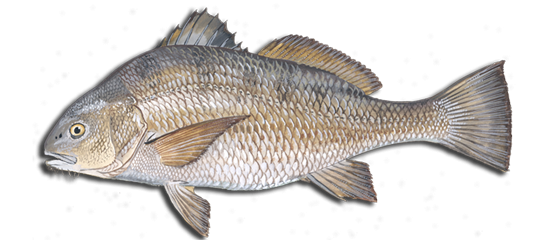Fish of Murrells inlet, SC: How to identify Black Drum
Fishing enthusiasts in Murrells Inlet, SC, have a chance to encounter the intriguing Black Drum, recognizable by its distinct features and behavior. Its scientific name, habitat within Murrells Inlet, SC, and characteristics will be explored in this piece, sourced from the South Carolina Department of Natural Resources for accuracy and credibility. Stay tuned for expert tips and tricks on identifying and targeting this exciting species, as we dive deep into the world of Black Drum fishing!
Introduction to Black Drum
Scientific Classification
The Black Drum, known to scientists as Pogonias cromis, belongs to the family Sciaenidae. This family includes both drums and croakers, often recognized for the drumming or croaking sounds they produce. These sounds come from their ability to vibrate their swim bladder using special muscles. Black Drum are robust fish, with a high back and a generally gray or black coloration. They can grow quite large, with some reaching over 100 pounds, though most encountered by anglers in Murrells inlet fishing areas are smaller juveniles. Understanding their scientific classification is not just about biological curiosity; it’s crucial for recognizing the importance of the species within its ecosystem and the role it plays in the balance of marine life in Murrells Inlet, SC.
The Black Drum and Murrells Inlet
Black Drum are a common sight for those engaged in Murrells inlet fishing, residing in these waters year-round. Murrells Inlet, a famed estuary in South Carolina, provides the perfect backdrop for Black Drum to thrive. The inlet’s mix of salt and fresh water creates an ideal habitat for various life stages of the Black Drum. Juveniles prefer the shallow, brackish waters where they can find shelter and an abundance of food. As they mature, these fish often move to deeper waters, sometimes venturing offshore but commonly staying within the inshore waters. Anglers appreciate Black Drum for their fighting spirit and the challenge they present on the line. The species’ presence in Murrells Inlet not only adds to the area’s biodiversity but also contributes to its reputation as a premier fishing destination.
Understanding Fish Habitats in Murrells Inlet, SC
The Unique Environment of Murrells Inlet
Murrells Inlet, SC, is renowned for its rich and diverse marine ecosystem, making it a haven for fishing enthusiasts. Its waters are a complex network of marshes, tidal creeks, and estuaries, providing an abundance of habitats for various fish species, including the Black Drum. The unique environment supports a broad food web, ranging from microscopic plankton to large predatory fish. This intricate system is essential for the growth and survival of juvenile fish, which use the marsh grasses and oyster beds as protection from predators and as hunting grounds for their own prey. For anglers, the diverse environment means that Murrells inlet fishing offers the chance to catch a wide variety of fish, ensuring that every trip to these waters is both challenging and rewarding.
Black Drum and their Preferences
Black Drum are adaptable fish that have specific habitat preferences, which play a key role in their development and survival. In the waters of Murrells Inlet, they are often found around oyster beds, piers, and bridge pilings where the water is brackish—a mixture of fresh and saltwater. These areas are teeming with crustaceans and small fish, the primary diet of Black Drum. As they grow, their diet expands to include mollusks, which they can crush using their powerful pharyngeal teeth. The bottom-dwelling nature of Black Drum means they are often found near or on the muddy or sandy bottom, where they can root around for their prey. Understanding these preferences is essential for anglers who are looking to target Black Drum during their Murrells inlet fishing expeditions, as it allows them to pinpoint the most likely spots to find and catch this sought-after species.
Practical Guide to Identifying Black Drum
Key Identification Features
To correctly identify Black Drum during your Murrells inlet fishing adventures, look for several distinctive features. First, their color ranges from gray to black with a high arch in their back. Younger Black Drum often have vertical stripes along their bodies, though these tend to fade as the fish matures. They also have a characteristic barbel located on their chin, which they use to detect prey along the sandy or muddy bottoms. Another notable feature is their large dorsal fin, which is rounded and contains one or two spines. Black Drum’s tail fin is generally broad and square, helping to distinguish them from other species. Finally, the most definitive feature might be the drumming sound they produce, especially during spawning seasons. These identification markers make the Black Drum a distinctive catch for any angler in Murrells Inlet, SC.
Distinguishing Black Drum from Similar Species
When fishing in Murrells Inlet, SC, it’s important to distinguish Black Drum from similar species to ensure a successful and responsible catch. Red Drum, also known as Redfish, are often mistaken for Black Drum. However, Red Drum typically have a spot or several spots at the base of their tail fin, while Black Drum do not. The mouth of a Black Drum is positioned more downward, suited for bottom feeding, unlike the Red Drum’s more forward-facing mouth. Sheepshead is another species that shares the same habitat and can be confused with juvenile Black Drum due to their vertical stripes. Yet, Sheepshead possess very pronounced teeth, designed for crushing shells, which are not found in Black Drum. By closely examining these features, anglers can not only correctly identify their catch but also contribute to the conservation of the species by following proper fishing regulations in Murrells inlet.
Resources and Further Reading
The South Carolina DNR Resource
For comprehensive information on Black Drum and other species found in Murrells Inlet, SC, the South Carolina Department of Natural Resources (SCDNR) is an invaluable resource. The SCDNR provides detailed data on the habitats, biology, and conservation status of marine wildlife, including regulations that anglers must follow. The SCDNR’s resources help ensure that fishing activities are sustainable and that the diverse ecosystems of South Carolina’s coastal waters are preserved for future generations of anglers. By accessing the SCDNR’s resources, fishermen can stay informed about size and catch limits, helping to maintain the health of the Black Drum population in Murrells Inlet. The SCDNR also offers educational materials and guides, perfect for those looking to deepen their understanding of the local marine environment and improve their fishing techniques.

Fishing Tips and Tricks from Experts
Seasoned anglers have accumulated a wealth of knowledge on how to effectively catch Black Drum in Murrells Inlet. One key tip is to fish during high tide, as Black Drum move into the shallows to feed. Using fresh bait such as shrimp, crabs, or cut mullet can significantly increase your chances of a good catch. Experts also suggest using a bottom rig to keep the bait near the sandy bottom where Black Drum forage. Patience is crucial, as these fish may take some time to find and bite the bait. Additionally, quietness and minimal movement can be beneficial, as Black Drum are known to be wary of noises and abrupt changes in their environment. Visit Our Tips and Tricks page Here for more fishing knowledge.




